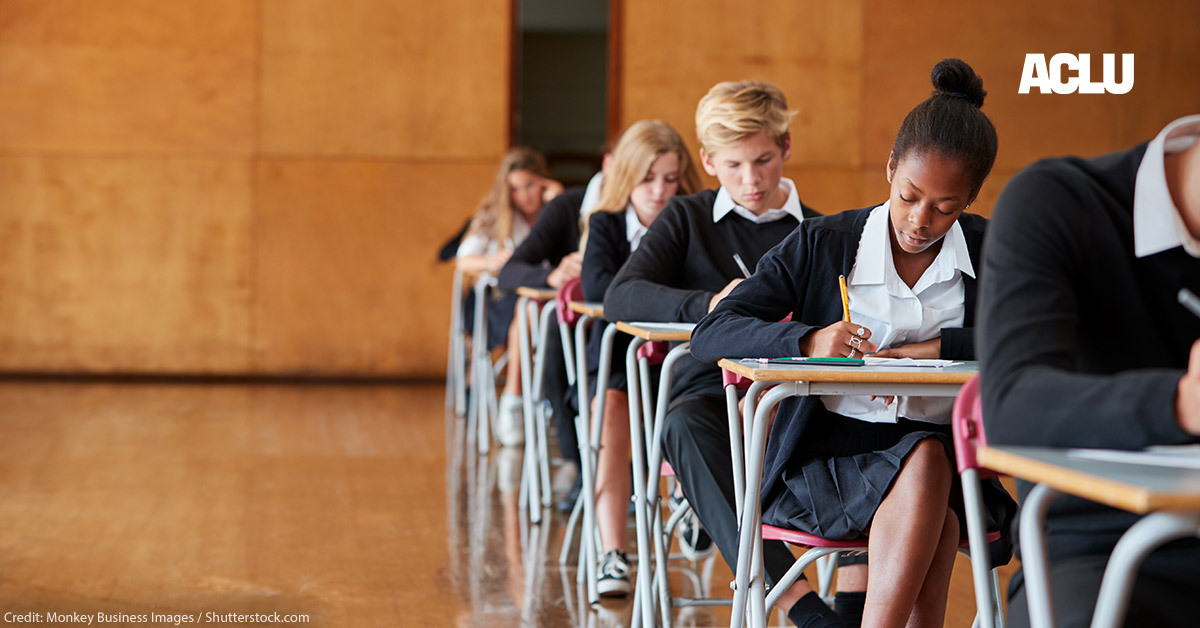

Most students have encountered school dress codes in one form or another - from bans on spaghetti straps or crop tops, to restrictions on certain hair styles, hair length, and head coverings. Despite how common they are, school dress codes and grooming policies often reflect and reinforce outdated and sexist stereotypes, and may be disproportionately enforced against students who are more likely to be policed or perceived as deviant by school officials.
School dress codes, for example, may reflect the sexist and harmful view that girls’ bodies are inherently vulgar or inappropriate, that boys will be “distracted” by girls’ bodies, and that girls’ dress and appearance require more regulation than that of boys. Such policies also may punish LGBTQ+ students for not conforming with rigid and binary gender norms about proper behavior and appearance. Moreover, students of color - and especially Black girls and other girls of color - are disproportionately targeted for dress code enforcement because of intersecting race and gender stereotypes. Black girls, in particular, are often seen as less innocent and more adult-like, aggressive and threatening, and needing less support and protection - often known as the “adultification bias.”
You may be left wondering where the line is between a permissible dress code and unlawful discrimination. Here’s the short answer: While public schools are allowed to have dress codes and uniform policies, they cannot discriminate against certain students or censor student expression.
Here are a few of the basics on what public schools can and cannot do when it comes to dress codes:
That means that while dress codes may specify types of attire that are acceptable, these requirements may not differ based on students’ gender, race, religion, or other protected characteristics. Under federal laws protecting against discrimination in education - including Title IX, Title VI, and the U.S. Constitution’s equal protection guarantee, public schools cannot enforce a dress code based on gender- or race-based stereotypes about appropriate dress or appearance. For example, a public school cannot require girls, and only girls, to wear skirts or dresses, or require boys, but not girls, to wear short hair. This also goes for special events and occassions - such as prom, graduation, or yearbook photos. For example, while a public school can require “formal attire” to be worn at special events, it may not require that girls, and only girls, wear gowns - or that boys, and only boys, wear a suit.

Schools cannot enforce dress codes in ways that discriminate against people for who they are. Students, your body is a not a problem. Know your rights.
This is because the clothing, accessories, and hairstyles we wear are part of how we express our identity, and because schools cannot force students to conform their appearance or behavior based on rigid and discriminatory gender norms and stereotypes. For example, a public school may not enforce a dress and grooming policy that prohibits boys, and only boys, from wearing nail polish, or imposes rigid restrictions on hair length based on gender. Such dress codes marginalize non-binary, transgender, and gender-nonconforming students, and ultimately send the message that these students do not belong.
Even when a dress code appears to be “neutral” on its face, a public school may violate students’ civil rights by targeting enforcement of its dress code against certain groups of students. For example, public school dress codes that ban “cleavage” or “bra straps” - or impose restrictions on the length of shorts or skirts - are often targeted against girls and invites unnecessary and excessive policing of girls’ bodies in schools. The ACLU has expressed concerns about potential discrimination where a school targeted dress code sweeps against girl students, and where a school district suspended girl athletes for practicing in sports bras, while allowing boy athletes to practice without shirts.
Moreover, Black students and other students of color are often more harshly disciplined and targeted for dress code enforcement based on racist stereotypes about proper appearance and behavior. Notably, dress and grooming policies that prohibit certain hairstyles - including hair extensions, braids, or locs - often disproportionately punish Black students and are rooted in racist standards of professionalism and respectability. In 2018, the ACLU and the NAACP Legal Defense Fund raised legal concerns when a Florida school turned away a Black first grader for wearing locs on his first day of school. However, it is worth noting that courts have been less consistent about applying antidiscrimination laws to grooming policies, and your protections may vary greatly based on where you live.
Restrictions on head coverings and certain hairstyles also raise significant concerns regarding religious and racial discrimination. Students from some religious backgrounds may wear head coverings or longer hairstyles due to religious reasons, and public schools may not impose restrictions that conflict with students’ religious freedom.
The Supreme Court has recognized that public school students do not “shed their constitutional rights to freedom of speech or expression at the schoolhouse gate.” The First Amendment prohibits schools from picking and choosing which views students are allowed to express. All views must be treated equally, so long as they are not obscene or disruptive. This means that if a school permits items like t-shirts with slogans, buttons, or wristbands, it has to permit them no matter what message they express.
What this boils down to is that public schools’ authority to impose dress codes is not unlimited. Students should be informed of their rights so they can speak out if there are violations. And school administrators must reexamine their dress codes to ensure that they do not violate students’ civil rights and liberties.
Does your school have a dress code that treats people differently based on gender, race, or other protected characteristics? Let us know by filling out this form.

Does your school or workplace have dress and grooming policies that treat people differently based on gender stereotypes? Share your story with us.
Source: American Civil Liberties Union
Click here for a handy fact sheet outlining your rights related to school dress codes and grooming policies, gender identity, and self-expression. Share this and our latest podcast episode with a friend!